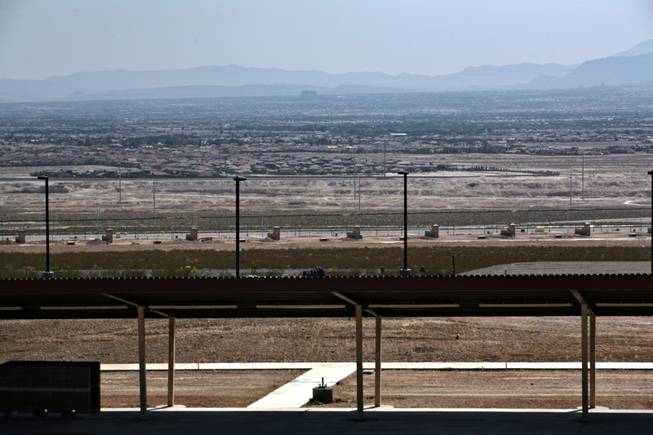
The Clark County Shooting Park, under construction north of Interstate 215 between Decatur Boulevard and Buffalo Drive, is expected to be open to the public no later than October, though the Nevada Environmental Coalition is trying to stop it.
Wednesday, Aug. 19, 2009 | 2 a.m.
Related Document
Sun Archives
Beyond the Sun
The first portion of what is to become the largest shooting park in the nation is expected to open in the coming weeks, but the efforts to stop it are far from over.
The park’s 178-acre “public module” phase could get a tryout as soon as Aug. 25, Clark County Commissioner Tom Collins said Tuesday. Other county officials said it would be open to the public no later than October.
Nonetheless, on Monday the president of the Nevada Environmental Coalition filed a 15-page document with the Interior Department arguing that the psychological effects and the safety hazard of what is eventually to become a 2,900-acre shooting park in the north valley were not adequately studied. The local activist, Bob Hall, is trying to force the Bureau of Land Management to conduct a full-blown study of the environmental impact of the park.
After the public comment period ends in early September, the BLM will have 30 days to issue a “decision record,” which might include an agreement that more study is needed. The BLM’s Gayle Marrs-Smith said if that decision determines there is no significant impact from the shooting park, then another 30 days will be allowed for appeals.
Matt Callister, a lawyer representing neighbors of the park, said he is planning to step back into the fight, too. Callister has sent a letter saying that the BLM’s environmental assessment was “rudimentary, just another gloss, another sheen and doesn’t provide the level of assessment near the level they should be providing.”
His biggest worry, echoed in Hall’s document, is that if the shooting park is successful, “it’s going to be immense and it’s going to be busy, and the detrimental impact has not been calculated.”
Callister added that new momentum to turn as much as 35,000 acres to the park’s immediate west into a national monument has also not been adequately studied. The shooting park is north of Interstate 215 between Decatur Boulevard and Buffalo Drive, north of Moccasin Road at the base of the Sheep Mountains. An area being pushed by residents and the National Park Conservation Association for national monument status is to the west, also at the base of the mountain range.
“This is a major paleontological site,” he said, noting the thousands of ice age fossils found and many thousands more that scientists believe remain underground. “We’re going to raise that issue all the way screaming and showing how it conflicts.”
Marrs-Smith said the BLM is working on an environmental assessment on a portion of those 35,000 acres. That analysis will take into account the possibility of increased use if national monument status were to be attained, and whether that use would be compatible with the nearby shooting park.
But Callister said he isn’t confident that study will be enough.
“We’re far from done,” he said.
Neither is the county, Collins said. The “public module” is only one step toward opening the entire first phase, which will take up 900 acres and cost about $64 million.
The park has been the focus of local talk and county planning for more than two decades.
Federal land was formally transferred to the county in 2003, with the express purpose of building a shooting park.
Since then, as homes and development have moved north and gotten closer to the proposed area, neighbors have complained that when they purchased their homes they weren’t told a shooting park was going to be built nearby. Competing studies about noise from gunfire that will emanate from the site have been offered by the county and residents, who organized as a limited liability corporation, Residents for the Relocation of the Clark County Shooting Park.
With the help of Callister, the group filed a lawsuit. Homeowners argued they were not properly informed of the proposed use of the land, that a shooting range would violate county noise ordinances and that necessary environmental impact studies were never performed on the land.
Though a federal judge did not order an injunction against the park’s construction, he agreed that more environmental study was required, in part because the BLM was doing a study.
That report was released this month, but Hall said his analysis has convinced him that more study should be done.
He said, for one thing, the environmental assessment didn’t adequately consider the potential dangers of the shooting park. That, in turn, makes it more likely that “taxpayers will take it in the neck” if someone gets hurt at the park, he added.

Join the Discussion:
Check this out for a full explanation of our conversion to the LiveFyre commenting system and instructions on how to sign up for an account.
Full comments policy